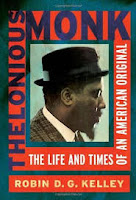I have occasionally tried to define my relationship to music. It’s not easy. I cannot say that I love reggae, or classic rock, or electronica. I own albums and music by artists who produce those types of music, but cannot outright say that I am a dyed in the wool reggae fan, for example. My feelings for jazz are the same. There are bits and pieces that I greatly enjoy; the majority, no. But I do own a dozen or so Thelonious Monk albums. Something about the man’s music attracts my ears, then soul. And with that I decided to pick up Robin D.G. Kelly’s biography to try and get a little deeper into what that “something” is in Monk’s music.
Thelonious Monk: The Life and Times of an American Original (2010) focuses on three primary things: the details of Monk’s character and personal life (heritage, upbringing, personality, relationships, marriage, children, etc.), the evolution of Monk’s music, style, gigs he performed, and albums he recorded, and lastly the relationships and partnerships that formed the social fabric he wove (and unwove) in the musical, mostly jazz scene of his era. As with good biographies, a strong sense of the history that Monk made and passed through emerges in the process.
I’ve not read any other biographies of Monk, and therefore cannot compare. But I can say Kelly’s seems a rigorous, detailed affair. ‘Exhaustive’ certainly not the word to apply: the writing is fluid and engaging throughout, key moments touched upon with just the right quantity before moving on. These steps take the reader on a journey from Monk’s birth to death, highlighting the major and minor milestones of his life, and perhaps most importantly for a lot of readers, the details behind many, many of his performances and all of the albums he recorded. From this tapestry of information, the source of the eccentric music that is Monk’s primary legacy, can be discovered.
Another component of the biography to appreciate is that Kelly remains open-ended when fact cannot be determined. Where some biographers are so close to their subject matter they cannot distance themselves, and thus present hearsay as fact, Kelly instead presents the reader with the differing perspectives, allowing them to form their own conclusions when facts are not clear. Not an excuse, the book appears extremely well researched given the number of references, cross-references, and quotes that are woven into the exposition, not to mention debunked myths and legends about the New York pianist.
Monk famous for music, and indeed Kelly goes into excellent detail. From the roots of Monk’s interest in the instrument to his early days around bop, from his haphazard groups to big label albums, from his jam sessions to European tours, from his relationships with publishers to a complete discography, Kelly clearly delved, and delved deep into the life and music of Thelonious Monk. Clearly recognizant many readers look to the pianist for his music and don’t care as much about the man’s personal life, Kelly delivers robust information to hang your hat on.
With all that is happening in the USA as of the middle of 2020, I can’t help but write this review without mentioning the parallels to Monk’s life in NYC in the 40s, 50s, and 60s. Race riots, police brutality, black aggression, and cycles of violence that aren’t able to stop themselves save with time, it seems America is destined to repeat itself without learning anything, or perhaps more precisely: the root of the problem still grows in fresh soil. By integrating the happenings on the streets of the city and US at large with the pianist’s beliefs and choices, Kelly indirectly draws attention to a real issue without distracting from the main focus of the biography, Monk and his music.
If I were to address anything to Kelly, one item would be the sharpness with which he addresses the darker side of Monk’s behavior. There is certainly sympathy given to Monk’s manic depressiveness, so don’t let me lead you down that road. At the same time, Monk could be a cantankerous asshole by any measure. There are moments Kelly calls out Monk’s rude behavior or poor handling of relationships, but it’s always with a soft edge, a pulled punch that could have taken a stronger stand looking at Monk’s less idyllic actions and decisions. Perhaps Monk’s personage is still too fresh in the public eye for such hard-edged commentary to be accepted. Perhaps in fifty years a stronger view to those aspects of Monk’s life will become accepted part of his character. It’s there between the lines, but I wish Kelly had been a little more realistic as to this side of the man’s character.
That being said, Thelonious Monk is all a reader could want in a biography. The angular, off-key melodies and rhythms he is famous for had parallels in his personal life, and the book addresses them in black and white. While perhaps not taking the man to task enough (for example, being absent from his first child’s birth, or hours late to his mother’s funeral), the biography nevertheless paints a complete picture of the man, his music, and his times. For anyone interested in Monk, jazz in the mid-20th century, or the history of NYC around the same time, the book is a must read.


No comments:
Post a Comment